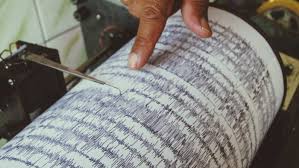Did you ever realize that there is but one natural disaster that we “don’t” get a heads-up about?
I didn't either. That is, until I read about it.
It seems that every natural disaster except the earthquake gives some sort of notice albeit, a few hours to a few days – but at least it is notice right?
Think about it. Tornadoes, hurricanes, blizzards, snow storm, yeah even a volcano we at least get a little notice.
But with an earthquake, these events just sneaks up on you like a thief in the night.
Sure geologists have resources available to indicate a probability of when a quake will strike, but it is still impossible to provide any short-term notice. Further, even scientist can’t predict the date, time and place one will hit.
In fact, from what I've read, the most sensitive seismic instruments currently in use give no more than five minutes of warning of a major earthquake. That’s hardly enough time to freshen up my lip gloss let alone warn somebody of an earthquake! But then, how much time would we actually need to walk-on-water in the face of a disaster?
Oh, and just in case you’re thinking, “well earthquakes don’t happen here.” According to the U.S. Geological Survey's Earthquake Information Center, every state in the U.S. has experienced an earthquake at one time or another. That pretty much covers us all sister, sorry!
 There is no "Earthquake-Free" get out of jail card place in the world. Earthquakes can strike suddenly, violently and without warning anywhere in the world.
There is no "Earthquake-Free" get out of jail card place in the world. Earthquakes can strike suddenly, violently and without warning anywhere in the world.
So how the heck do you prepare for literally, the unknown? Good question.
There are some things that you can do that will at least make you feel that you’ve prepared as best you can.
First of all, I am going to assume you already have your “Get outta Town” bag (fondly referred to as the BOB – Bug Out Bag) packed and ready to go, to include your prescriptions and an extra pair of eye glasses, for a minimum of 72 hours up to a week. And, that you have on-hand cash, food, water, some sort of communication device (with batteries), and first-aid supplies (if not, girlie-girl, get your fanny going on these things right away!)
With that said, in your home make sure you know where all the safe areas are in your home such as doorways, under sturdy tables and desks to avoid being hit by falling debris and know where you can safely exit should the need arise. Also note the areas to avoid such as fireplaces, windows, mirrors (I know its tempting to want to check your hair and make-up but don’t) and, hanging objects.
Keep in mind most injuries result from falling debris or by people trying to move during the shaking. As soon as you feel/hear the rumbling, always drop, cover and hold on and, have a first-aid kit close by (or maybe even have a few placed in strategic areas throughout the house).
Also, have an adjustable pipe wrench for turning off gas and water, a fire extinguisher, and a flashlight or two. Whatever you do, don’t light any matches or attempt to light anything like a candle (that’s why we say have a flashlight)! With broken gas lines you could light the whole town up … including yourself!
Oh, while you are doing the dreaded house-cleaning thing, you may want to reconsider all those knick-knacks on shelves and pictures on the wall – just sayin – those can turn into missiles in the rumble.
Now, after you’ve done all your earthquake prep … for your reward … go buy yourself a pair of boots!
No not Gucci – a pair of sturdy boots - to keep from cutting your feet on any debris.
- Survivor Jane

Thank you in advance for sharing Survivor Jane with your friends!
If you have any questions, or would like to see a specific article addressing survival preparedness for women on SurvivorJane.com click here
Or contact Survivor Jane at editorial@survivorjane.com
Follow me on Twitter @SurvivorJane and use the hashtag #PrepperTalk where you will find the Largest Prepper Community on Twitter!

